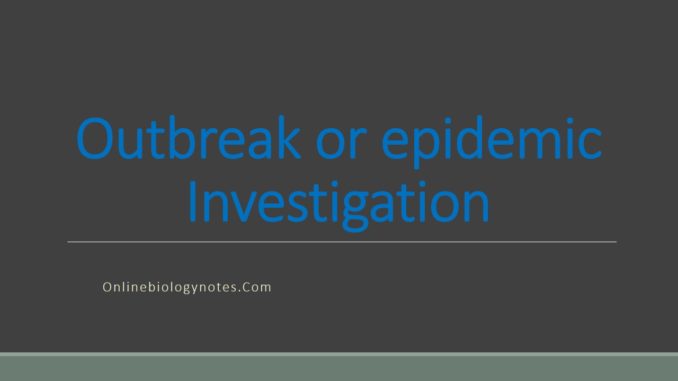
- Outbreak investigating involves a procedure to identify the causative agents of the disease, people infected, the circumstances and mode of transmission of the disease. It also involves identifying other relevant factors causing the propagating of epidemic, and to take effective measures to contain and prevent the spread of the disease.
- Investigation of an outbreak or epidemic requires proper planning and strategy.
Steps in outbreak investigation:
- Considered 6 headings:
- Preliminary enquiry
- Management of incidence
- Identification of cases and collection and analysis of data
- Control
- Communication
- Further epidemiological and lab studies
1. Preliminary inquiry:
- To confirm the reality of outbreak because the number of reported cases maybe increased due to improved and sensitive diagnostic procedure, changes in reporting, change in population size and false positive results.
- Intensive study on particular disease due to special interest.
- To confirm the provisional diagnosis of disease.
- To agree a case definition for epidemiological investigation
- To formulate tentative hypothesis of the source and spread of investigation
- To initiate immediate control measures it requires management of incidence.
2. Management of incidence:
- If outbreak is small, it Is usually managed by CCDC (consultant in communicable disease control) with the assistance of consultant micro-biologist and environmental health officers.
- If it is hospital outbreak, it is usually managed by control of infection officers assisted by infection control nurse.
- If outbreak is large, in addition to CCDC, a consultant microbiologist, consultant epidemiologists should be involved along with consultant medical officers.
3. Identification of unreported cases and collection and analysis of data:
- Identification of unreported cases are important for:
- Diseases spread from person to person, missed cases or carriers maybe responsible for spread
- In point source outbreak the present in cases may have come to light because of chance association with a place or potential vehicles of infection.
- Without knowing the population from which cases have come.
- The denominator of person at risk is not available to calculate attack rate and so determine whether or not a particular exposure was associated with an increase incidence of disease.
- The main aim of this study is also to collect data from those who have affected and those at risk but not affected for the knowledge of source and mode of infection.
4. Control:
- Control measure may be directed toward the source of infection, mode of transmission and people at risk.
- Control of source: source of disease may be human, animal or environment.
- Control of spread: Food
- Control of people at risk: immunization (active or passive) chemoprophylaxis
5. Communication:
- Accurate and timely information about outbreak is very important in control of outbreak, CCDC should inform local consultant physician, microbiologists, chief environmental health officers, director of public health and may also include local divisional veterinary officers, education officers, clinicians in hospital and general practice and similar people in neighboring areas.
6. Further epidemiological and lab studies:
- Analytical studies are necessary to confirm the association of disease with particular vehicles or source of infection.
